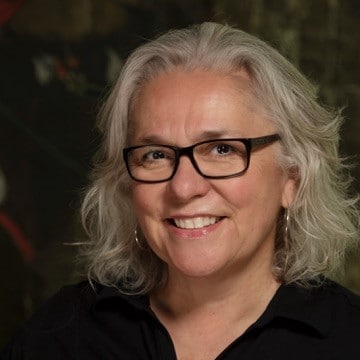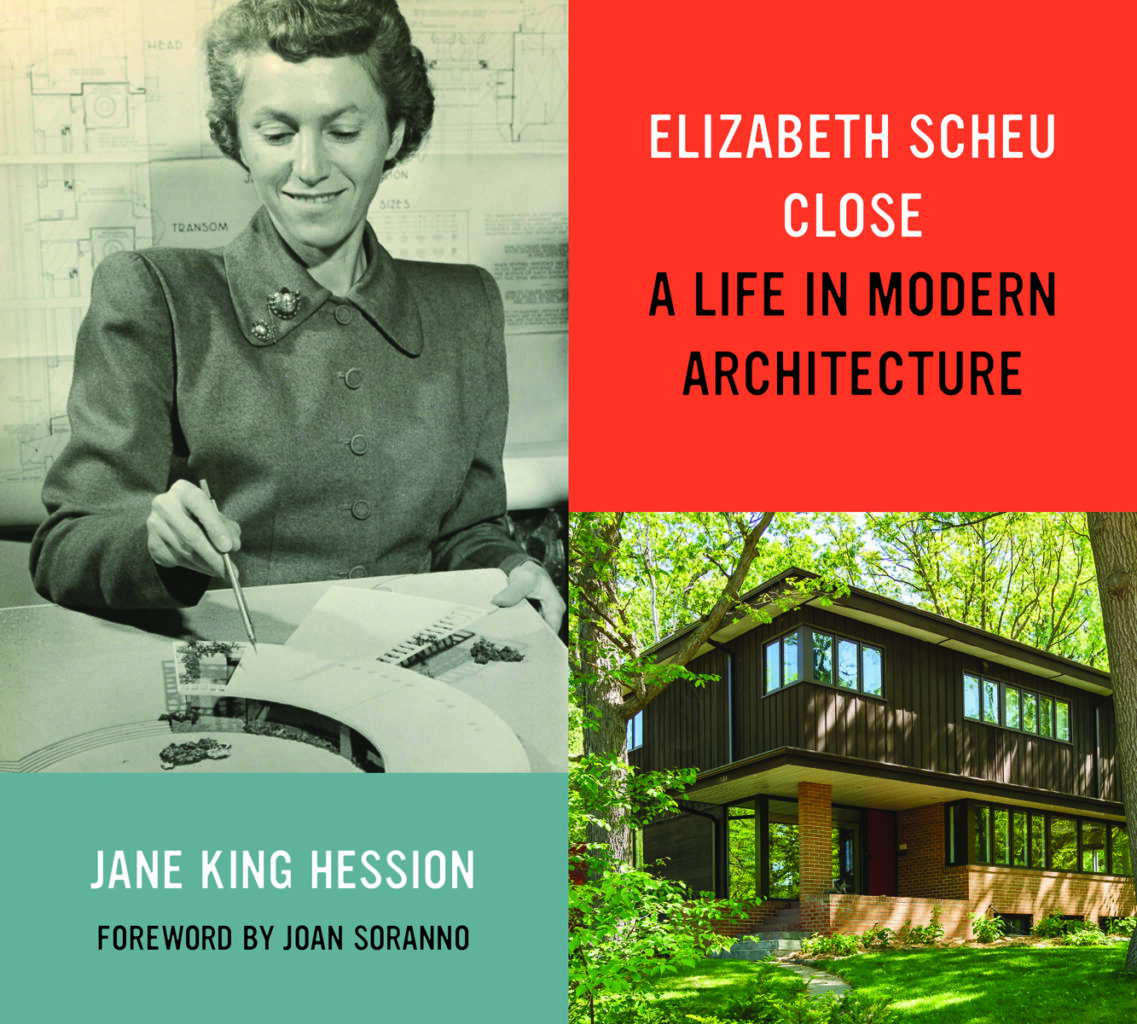Jane King Hession, author of Elizabeth Scheu Close: A Life in Modern Architecture
Emilie Buchwald Award for Minnesota Nonfiction, sponsored by Bookmobile Craft Digital
Each week leading up to the 33rd annual Minnesota Book Awards announcement, we are featuring exclusive interviews with our 36 finalists. You can also watch the authors in conversation with their fellow category finalists here.
In a year defined by a pandemic and its fallout, virtually everything about our lives has changed in some way. How has COVID-19 impacted your writing habits and preferences? Has the unique zeitgeist of the past year influenced your writing output in any ways that you can pinpoint?

Writing is a solitary, introspective pursuit but one that suits me. I am accustomed to spending long hours in my writer’s nook in every season and weather condition. In fact, I often feel most productive when I can lock myself away on a cold, snowy day and write. In that regard, the pandemic has not affected my focus or process, other than the fact that some archival research was more challenging to accomplish this year due to all the shut downs. But the pandemic did have a profound impact on the way this book left my possession and was published and released. Immediately after printing, all copies were literally locked in a warehouse for weeks. Although the creation of a book involves a very personal relationship between an author and the blank page, as it were, the ultimate goal is always to share your creation with a larger audience. In my case, I was eager to shine a light on Elizabeth Close’s remarkable life and career. But, like hundreds of other writers, artists, dancers, and performers, I learned this was a less than ideal year in which to share one’s labor of love. All but one of the many events, including an exhibition, planned to celebrate Elizabeth Close and publicize the book were cancelled due to COVID precautions. Understandably, much more serious issues consumed us all this year.
Would you tell us one or two things about your finalist book that you are particularly proud of, and why? (Sure, it may feel a bit un-Minnesotan to say so, but it’s not boasting if we ask!)
I am most grateful (and proud) that so many people trusted me and supported my efforts to write this book. As all authors know, it takes a village. They included Elizabeth “Lisl” Close herself, who died in 2011 at the age of 99, and her three children. The University of Minnesota Press, especially my editor Pieter Martin, who encouraged me to write the book I believed should be written. And members of the Minnesota architecture community–all friends, colleagues, and admirers of Lisl–whose financial support made publication possible. By the same token, having all that trust and support bestowed on you can feel like an overwhelming responsibility at times. There are moments when you do wonder if you will be able to deliver what you’ve promised. For that reason, I am very pleased (and proud) that my book was named a finalist for a Minnesota Book Award. Validation is a wonderful thing!
What do you hope that your audience learns or takes away from your book?

Beyond gaining an understanding of Lisl’s enduring architectural legacy, what I hope the audience learns from the book is that she let nothing stand between her and her goal of becoming a modern architect. There were many obstacles in her way, including her young adulthood in Vienna under the specter of Hitler and the Nazis, immigrating alone to a new country at the age of twenty, being a woman in the male-dominated field of architecture in the 1930s and beyond, balancing a profession and a family–the list is long. What I most admire about Lisl is that she did not lose hope or focus. She persevered and found a way around any roadblock thrown in her path, and she did so with grace and wisdom, which is why she succeeded. While there is no question that Lisl was a pioneering woman in her field, she didn’t believe her accomplishments should be embellished or qualified because of her sex. She simply wanted to do the best work possible. For these reasons, I hope one takeaway from the book is that perseverance and an unwavering belief in one’s self are keys to achieving one’s goals.
Minnesota enjoys a reputation as a place that values literature and reading. If this sentiment rings true for you, what about our home state makes it such a welcoming and conductive place for writers?
As is true of so many things of value, I believe our reading– and writer-friendly state begins at a grassroots level. For me, the prevalence of independent book stores, each one a treasure, speaks of a community that believes in the importance of the written word. Pandemic permitting, when I am feeling lost in my own work, I go to Birchbark Books simply to be among (and to purchase!) books in that peaceful, spiritual space. Or I’ll visit Wild Rumpus, where I always enter through the child-sized purple door. There is nothing better for the soul than watching parents and children explore books together in that magical environment. A trip to Minnesota Center for Book Arts, where I can touch paper and smell ink and coffee, is always a mood lifter. The fact that we have a program like the Minnesota Book Awards speaks volumes about the importance of writing and writers to Minnesotans. All these people, places, and organizations–and so many others dedicated to related arts–make possible the critical role literature and reading play in our quality of life. Creativity breeds creativity. But this gift isn’t something we should take for granted; we must do everything in our power to keep it alive. I’ve lived in other states where this simply doesn’t exist. That’s why I moved back to Minnesota. I’ve found my community here and know that, creatively speaking, anything is possible.
What advice would you give to an aspiring writer with an interest in your category?
I would say a fascinating journey awaits you. There are so many interesting people, places, and things in Minnesota–and the world–that merit exploration and documentation. If you don’t write that book, who will? But it’s important to learn your craft. The best was to do that is to read authors you admire–those who do what they do well. If you are interested in writing nonfiction, it is important to be rigorous with your research and to consult primary sources as much as possible––never assume anything. Although it is critically important to have a vision for the book you intend to write, it’s also important that prospective writers share their manuscript with as many knowledgeable readers and editors as possible. And to then take constructive criticism in the spirit in which it was offered–it always makes for a more error-free and richer book.
Tell us something about yourself that is not widely known! (It doesn’t have to be about your writing.)
I am an avid photographer, a passion I inherited from my father, who was rarely without a camera. Interestingly enough, I believe there is a connection between photography and the way I write. Photography insists on a focused view of the world, literally and figuratively. Framing a photograph forces me to make choices. Almost instinctively, I crop out things that are superfluous in order to focus on the essential. Through a photographic lens, it’s also possible to zoom into deeper levels, to see what is not immediately evident. That’s always in my head when I write. That kind of focus–knowing it’s important to zero in on key concepts––allows me to stay on track in my writing. When I’m working on a book, I often do photo research as I am writing. Because photographic documentation gives a verité to any subject, I am reminded that I am writing about a real person and real events. Sometimes the image even comes before the text. If I am at a loss for words, which often happens, I can usually find inspiration in an image. I believe there is an implied story in every photograph. If I look closely and consider what that story might be, words follow.
Jane King Hession is a Minnesota-based architectural historian specializing in modernism. She is a founding partner of Modern House Productions and the author of five books including John H. Howe, Architect: From Taliesin Apprentice to Master of Organic Design (Minnesota, 2014), Ralph Rapson: Sixty Years of Modern Design, and Frank Lloyd Wright in New York: The Plaza Years, 1954–1959.

